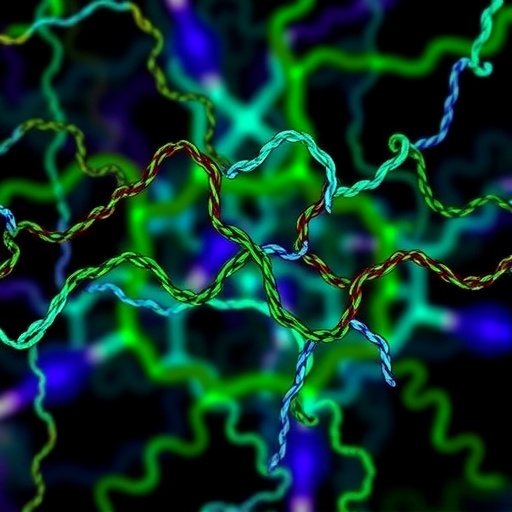In a groundbreaking advance that could reshape therapeutic approaches for Alzheimer’s disease (AD), researchers have unveiled a detailed mechanism by which short D-enantiomeric peptides dismantle ultra-stable tau fibrils, offering fresh hope against one of the most elusive neurodegenerative disorders. The study illuminates how these small peptides—once considered unlikely champions against the formidable protein aggregates in AD—exploit molecular strain to fragment pathological tau assemblies, a revelation poised to invigorate the search for effective Alzheimer’s treatments.
Alzheimer’s disease, characterized by progressive cognitive decline, is tightly linked to the abnormal aggregation of tau proteins inside neurons. These tau fibrils form highly stable amyloid structures resistant to degradation, enabling them to seed pathological cascades that devastate brain function. Despite intense research focus, no current therapies effectively disassemble these tau aggregates in the brain. Against this backdrop, the discovery that certain D-enantiomeric peptides can physically disrupt these fibrils without external energy sources marks a significant conceptual leap.
Prior efforts had identified the D-peptide D-TLKIVWC as a potent in vitro agent capable of breaking down tau fibrils extracted from postmortem AD brains into benign fragments. However, the detailed mechanistic underpinnings of this disassembly remained enigmatic, leaving a critical gap between observation and therapeutic application. The new research bridges this gap by elucidating how the assembly behavior of these peptides underpins their fibril-breaking power, revealing a sophisticated process reliant on conformational strain modulation.
Central to this process is the propensity of the D-peptides to form what researchers term “mock-amyloid” fibrils—aggregates mimicking amyloid geometry but distinct in handedness and flexibility. Unlike classical amyloid fibrils, these mock-amyloids exhibit a right-handed helical twist that is exquisitely adaptable when interacting with AD tau fibrils. Upon templating on the left-twisted tau aggregates, the mock-amyloid fibrils adopt a constrained left-handed twist, creating an intrinsic torsional strain.
This torsional strain acts as a highly focused molecular spring, primed for release. When the mock-amyloid fibrils relax from the constrained left-handed form back to their energetically favored right-handed twist, the resultant release of torsional strain generates mechanical torque. It is this biomechanical force that is sufficient to destabilize the dense hydrogen-bond network stabilizing tau fibrils. Fragmentation ensues as the fibril’s tau molecules wrench apart, effectively disassembling the pathological assembly without relying on enzymatic activity or external energy sources.
What makes this mechanism captivating is its elegance and universality. The research suggests that such strain-relief mediated torque generation may be a conserved principle underlying other examples of amyloid fibril disassembly, extending potential impact beyond just tauopathies. By harnessing intrinsic architectural conflict within beta-sheet assemblies, these short peptides offer a revolutionary blueprint for neutralizing amyloids associated with a spectrum of protein misfolding diseases.
The discovery also challenges prevailing assumptions about handedness in amyloid formation, emphasizing the nuanced geometric relationships that govern fibril stability. The interplay between right- and left-handed twisting in fibril assemblies represents a new dimension of structural biophysics with broad implications. Unraveling how such subtle conformational shifts translate into macroscopic biomechanical outcomes could unlock novel intervention strategies in the future.
Importantly, the study underscores the therapeutic potential of D-peptides, which are chemically stable, protease-resistant, and biocompatible. Their ability to infiltrate brain tissue and exert mechanical disassembly without eliciting harmful immune responses makes them attractive drug candidates. Leveraging their self-assembling behavior to introduce strain-based disruption expands the arsenal of tools for targeting previously intractable amyloid aggregates.
The implications extend towards designing next-generation therapeutics that do not merely bind amyloids passively but actively induce fragmentation through controlled mechanical effects. This approach could circumvent common pitfalls of amyloid-targeting strategies, such as immunogenicity and off-target interactions, presenting a more precise and effective modality for disease modulation.
Moreover, the research navigates the challenging terrain of connecting molecular biophysics with clinical pathology. By using tau fibrils directly extracted from the brains of Alzheimer’s patients, the findings provide physiologically relevant insights that elevate their translational relevance. This proximity to authentic pathological specimens distinguishes the study from those relying solely on synthetic fibril models and enhances the credibility of proposed therapeutic pathways.
As the global burden of Alzheimer’s disease escalates, the need for interventions that halt or reverse neurodegeneration has never been more urgent. This study paves a promising path forward by revealing a fundamentally new mode of amyloid disassembly, driven by molecular strain release and mechanical torque. Its integration of peptide chemistry, structural biology, and biophysical mechanics exemplifies the interdisciplinary innovation critical for breakthroughs in complex diseases.
Looking ahead, validating this mechanism in living systems and optimizing peptide candidates for brain delivery and specificity will be crucial next steps. The potential to generalize this strain-driven disassembly concept to other amyloid diseases such as Parkinson’s and Huntington’s presents an exciting frontier. Ultimately, harnessing the power of mock-amyloids to break down pathological fibrils might transform the therapeutic landscape of neurodegeneration.
In summary, the revelation that short D-peptides dismantle Alzheimer’s tau fibrils through strain-relief mediated torque introduces a new paradigm in amyloid research. This elegant mechanistic insight not only deepens understanding of protein aggregation dynamics but also inspires innovative therapeutic strategies based on mechanical disruption. As research progresses towards clinical translation, these findings offer renewed hope that the progression of Alzheimer’s disease may one day be halted, changing the course of a devastating epidemic.
Subject of Research: Mechanism of tau fibril disassembly by D-enantiomeric peptides in Alzheimer’s disease
Article Title: How short peptides disassemble tau fibrils in Alzheimer’s disease
Article References:
Hou, K., Ge, P., Sawaya, M.R. et al. How short peptides disassemble tau fibrils in Alzheimer’s disease. Nature (2025). https://doi.org/10.1038/s41586-025-09244-z
Image Credits: AI Generated




